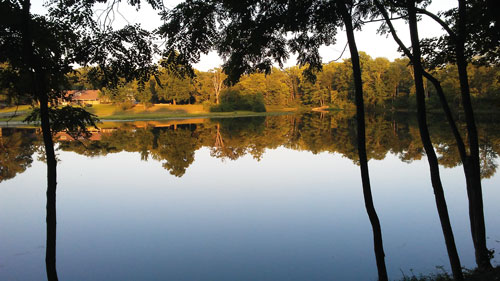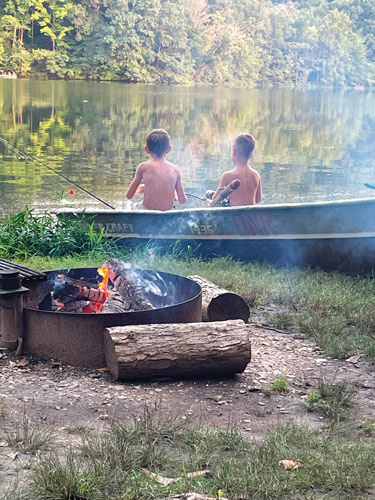About Outdoor Indiana
Outdoor Indiana, the state's premier magazine, delivers the wonders of the Hoosier outdoors to subscribers' homes and offices six times a year in 48 pages of vibrant color. For the best of state parks, lakes, wildlife, forests, trails, hunting, fishing, wildflowers and outdoorsy people, plus inside information from DNR experts, subscribe for $15 per year or $28 for two years. Follow the magazine staff on Facebook.
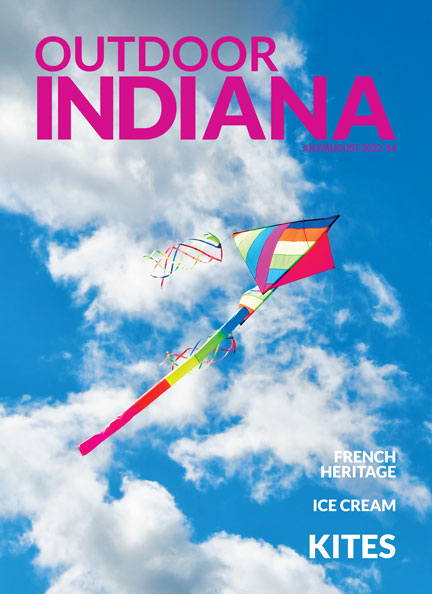
A kite soars at last year’s Merritt Beck Memorial Kite Fly in Muncie, sponsored by the Hoosier Kitefliers Association.
Photo by John Maxwell.
Featured Stories
- From the Director
CELEBRATE SHADES’ SAVED WONDERS

DNR Director Dan Bortner
On Saturday, July 16, Shades State Park will celebrate its 75-year history. Many exciting activities will be offered, including Race the Ranger hikes through the ravines beginning at 11 am. Food trucks will be on hand for lunch, and the afternoon will be full of family-friendly activities: a fossil hike, a history walk, crafts, games, and more.
Often overshadowed by its Sugar Creek neighbor, Turkey Run State Park, Shades is a place to find solace and inspiration, and to make memories. But at one point, Shades’ future was in jeopardy.
In 1947, this magazine asked readers to help “Save the Shades”. The “last remaining stand of virgin trees in Indiana” was being threatened, and Gov. Ralph F. Gates’ only course of action was a fundraising drive to purchase the property.
The campaign, placing the fate of Shades in “the hands of the park-conscious people of Indiana”, asked Hoosiers to donate at any Indiana bank or mail checks simply addressed to “Save the Shades, Indianapolis, Ind.” Shortening the property’s original moniker, “The Shades of Death”, was also probably a smart marketing move!
Civic groups and citizens from across the state supported this “investment in the future of Indiana.” One year later, more than 10,000 Hoosiers turned out for a day-long ceremonial celebration for the opening of Shades State Park, the place that Gov. Gates proclaimed to be “the Yellowstone of the Midwest”.
We hope you will join us in celebrating “The Shades” and the foresight of past Hoosier generations.
- INDIANA’S FRENCH CONNECTION
Roots with country’s oldest ally run deep
By Marty Benson, OI staff
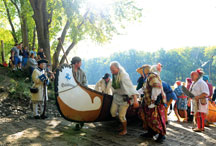
Members of the Ouiatenon Brigade bring their canoe ashore from the Wabash. Formed in 1973, the brigade participates in the Feast every year, portraying the lives of French voyageurs. Brent Drinkut photo.
Next time you’re driving along one of the state’s major rivers, take note of the place names. Many are French in origin.
Terre Haute, Lafayette, and Vincennes are prime examples, and the first fort in the Fort Wayne area was called Fort des Miamis.
Even the name of the state river, the Wabash, has some French-ness, which an alternative spelling, Ouabache, as in the name of the state park near Bluffton, makes clearer. The Miami-Illinois tribes’ name for the waterway was waapaahšiki siipiiwi, from which the French formed their name. Even some of the straight-up English names in Indiana have French origin. South Bend and Portage are examples, referring to the way their geography influenced French navigation.
Motoring beside the major rivers of Illinois, Iowa, and Missouri provides a similar experience to Indiana’s, as does driving next to those of Michigan, Wisconsin and Minnesota.
That’s because long before the British became the major European power in what would become Indiana and those other states, they were part of New France, a designation you may not have heard of before. The term obviously had a much shorter life than “New England”—despite that war for independence our ancestors fought against the Redcoats, with France as our ally.
A giant swath of today’s Midwest, from the Great Lakes to and including the state of Louisiana, with the Mississippi River as its western boundary, came to be called New France by those of European descent mainly because of its abundance of furbearing wildlife. The southern portion, in its entirety, was called Louisiana, aka Pays en Bas. The northern portion was called Canada, aka Pays en Haut. If you don’t know or haven’t thought of Indiana’s French heritage since elementary school—or ever—you’re not alone. It’s often ignored or forgotten.
The reasons are many. One is that France and its Native American allies lost the French and Indian War to the British and their Native American allies. The result of the conflict, called the Seven Years War in Europe, accounts for English eventually becoming the official tongue of the local Europeans.
Another factor is that the French came to trade with the Native people. They also intermingled culturally, including intermarriage. The British, by contrast, wanted land. Even as they took it, they encouraged the French people to stay. Many did. And the French place names, if not their French pronunciations, lived on.
A movement is afoot to kindle, rekindle, or nurture the Midwest’s inherent French-ness. Launched two years ago, the initiative has collectively dubbed the area and its group of one-per-state ambassadors the French Heritage Corridor (FHC).
- FROZEN DELIGHT
Cold snack leaves its mark on the Hoosier state
By Scott Roberts, OI staff
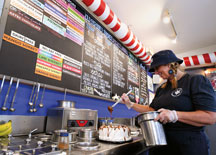
Cathy Brown decorates a Valpo Velvet ice cream cake. (Above) Colorful ice cream cones at Valpo Velvet. Brent Drinkut photo.
I scream, you scream, we all scream for ice cream.
That rhyme, originally from a 1927 song by Fred Waring and the Pennsylvanians, has stayed around for more than just its catchy phrasing. The vast majority of us really do crave the dessert, according the National Frozen and Refrigerated Foods Association. Its study concluded 98% of all U.S. households purchase ice cream, and 87% have some in their freezer at any given time.
Indiana has played a major role in fueling the country's ice cream passion. The state is second to California in ice cream production according to the Indiana State Department of Agriculture, partially thanks to large production facilities from dairy giants Edy’s and Prairie Farms in Fort Wayne. Good Humor has a facility in Huntington.
These companies locate in the Hoosier state partially because Indiana is a major dairy producer. The state is 14th in dairy production, with its approximately 750 dairy farms producing 371 million pounds of milk in 2020, which was up 9.8% from 2019.
A few factors give Indiana an edge on other states according to Christy Coon, the creamery license division manager at Purdue University. Her job is to monitor the weighing and sanitizing of Indiana milk and make sure the process runs smoothly. She also runs Round Barn Creamery with her husband and grew up on a dairy farm in the Lafayette area. She says cows are comfortable in Indiana’s climate for much of the year, and Indiana’s agricultural industry grows a lot of corn, hay, and soybeans, which cows like to feed on.
Indiana’s location also plays a part. Being in the Midwest means the ability to ship milk most places in the U.S. relatively quickly, and our many interstates mean the state has the transportation system to get it where it needs to go. Finally, Coon says Indiana receives free advertising from the Indy 500 when its winner drinks milk during the post-race celebration every year. These factors have combined to give Indiana a rich ice cream culture it still enjoys today.
- READY FOR TAKEOFF
Kites serve many forms and FUNctions
By Scott Roberts, OI staff
Photography by John Maxwell, OI staff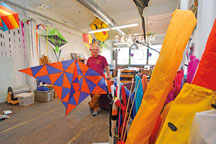
Grant Lovett designs and builds award-winning kites in his Indianapolis studio. Making a kite can be simple or complex, depending on what you want the kite to do and the materials you have.
Kite flyers have many reasons for taking to the skies.
The first documented kite flying happened in 200 B.C., when Chinese general Han Hsin of the Han Dynasty flew a kite over the walls of a city he was attacking to measure how far his army would have to tunnel to elude his target’s defenses.
Archaeological evidence suggests kites were also flown in Malaysia, Indonesia, and the South Pacific around that time. Made of leaves and reeds, their kites were used to catch fish.
Benjamin Franklin’s famous experiment with a key on the end of a kite that proved lightning was made of electricity is an example of kites used for science. Wilbur and Orville Wright studied the way kites caught the wind and stayed there, which helped them design their Wright Flyer.
The allure of kite flying is that it can be molded to wherever your interest lies, for nearly whatever purpose, said Mary McManmon of South Bend, president of the Hoosier Kitefliers Society (HKS). The club’s members fly kites for show, to perform tricks with them, or to pit them against each other in competition.
“Some people concentrate on stunt kites, some people do a little of everything,” she said. “I fly show kites, do ground displays, and do some kite making.”
Indiana has its own rich heritage of kite designers and flyers. Ansel Tony was known as the “Kite Man of Indiana” and became nationally known for those he created. He was featured on “CBS This Morning” years ago in one of Charles Kuralt’s “On the Road” segments. Merritt Beck learned from Tony and kept the kite tradition alive. HKS holds annual events named after both men. Tony and Beck’s legacies were documented in the March/April 2009 OI.
Many Hoosiers of today carry on the state’s tradition by finding their own ways to make and fly kites.
Reader Photos
Each issue, Outdoor Indiana staff will select reader submitted photos to feature in the magazine. If you would like the chance to be featured, please submit your photo, along with your name and phone number to:
Please, only submit original photography that you have taken. Do not send files over 9 MB in size. JPG format is preferred.
Subscribe to Outdoor Indiana magazine
Visit the Indiana State Parks online store to subscribe. Cost is $15 for a one year subscription (6 issues) or $28 for two years (12 issues).
Donate
Printing and distribution costs for Outdoor Indiana magazine have increased. One way we’re offsetting these costs is through the Friends of Outdoor Indiana Group administered through the Indiana Natural Resources Foundation. Donations to our friends group helps keep our subscription price low and ensures we’ll be around to bring you the best of Indiana’s outdoors for years to come. Donate at the INRF website and include “Friends of Outdoor Indiana” in the “In Honor Of/In Memory Of” line.
Outdoor Indiana
402 W. Washington St., W255-B
Indianapolis, IN 46204
317-233-3046
OIorders@dnr.IN.gov

